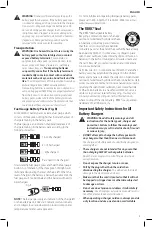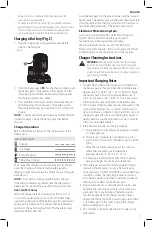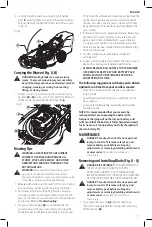
English
6
for outdoor use.
Use of a cord suitable for outdoor use
reduces the risk of electric shock.
•
An extension cord must have adequate wire size
(AWG or American Wire Gauge) for safety.
The smaller
the gauge number of the wire, the greater the capacity
of the cable, that is, 16 gauge has more capacity than 18
gauge. An undersized cord will cause a drop in line voltage
resulting in loss of power and overheating. When using
more than one extension to make up the total length,
be sure each individual extension contains at least the
minimum wire size. The following table shows the correct
size to use depending on cord length and nameplate
ampere rating. If in doubt, use the next heavier gauge. The
lower the gauge number, the heavier the cord.
Minimum gauge for Cord sets
Volts
Total length of Cord in Feet
(meters)
120 V
25 (7.6)
50 (15.2) 100 (30.5) 150 (45.7)
240 V
50 (15.2) 100 (30.5) 200 (61.0) 300 (91.4)
Ampere Rating
American Wire gauge
More
Than
not
More
Than
0
6
18
16
16
14
6
10
18
16
14
12
10
12
16
16
14
12
12
16
14
12
Not Recommended
•
Do not place any object on top of the charger or
place the charger on a soft surface that might block
the ventilation slots and result in excessive internal
heat.
Place the charger in a position away from any heat
source. The charger is ventilated through slots in the top
and the bottom of the housing.
•
Do not operate the charger with a damaged cord
or plug.
•
Do not operate the charger if it has received a sharp
blow, been dropped or otherwise damaged in any
way.
Take it to an authorized service center.
•
Do not disassemble the charger; take it to an
authorized service center when service or repair
is required.
Incorrect reassembly may result in a risk of
electric shock, electrocution or fire.
•
Disconnect the charger from the outlet before
attempting any cleaning. This will reduce the risk of
electric shock.
Removing the battery pack will not reduce
this risk.
•
NEVER
attempt to connect 2 chargers together.
•
The charger is designed to operate on standard
120V household electrical power. Do not attempt to
use it on any other voltage.
This does not apply to the
vehicular charger.
WARNING:
Shock hazard. Do not allow any liquid to
get inside the charger. Electric shock may result.
WARNING:
Burn hazard. Do not submerge the
battery pack in any liquid or allow any liquid to
enter the battery pack. Never attempt to open the
battery pack for any reason. If the plastic housing of
the battery pack breaks or cracks, return to a service
center for recycling.
CAUTION:
Burn hazard. To reduce the risk of injury,
charge only
D
e
WALT
rechargeable battery packs.
Other types of batteries may overheat and burst
resulting in personal injury and property damage.
NOTICE:
Under certain conditions, with the charger
plugged into the power supply, the charger can
be shorted by foreign material. Foreign materials
of a conductive nature, such as, but not limited to,
grinding dust, metal chips, steel wool, aluminum
foil or any buildup of metallic particles should be
kept away from the charger cavities. Always unplug
the charger from the power supply when there is no
battery pack in the cavity. Unplug the charger before
attempting to clean.
Wireless Certifications and Safety Information
• This device is CAN ICES-3(B)/NMB-3(B) compliant.
• This device complies with Part 15 of the FCC rules and
Industry Canada License-exempt RSS standard(s).
Operation is subject to the following two conditions:
ʵ This device may not cause harmful interference, and
ʵ This device must accept any interference
received, including interference that may cause
undesired operation.
This equipment has been tested and found to comply
with the limits for a Class B digital device, pursuant to Part
15 of the FCC Rules. These limits are designed to provide
reasonable protection against harmful interference in a
residential installation. This equipment generates, uses and
can radiate radio frequency energy and, if not installed and
used in accordance with the instructions, may cause harmful
interference to radio communications. However, there is no
guarantee that interference will not occur in a particular
installation. If this equipment does cause harmful interference
to radio or television reception, which can be determined by
turning the equipment off and on, the user is encouraged
to try to correct the interference by one or more of the
following measures:
ʵ Reorient or relocate the receiving antenna.
ʵ Increase the separation between the equipment
and adaptor.
ʵ Connect the equipment into an outlet on a circuit
different from that to which the adaptor is connected.
ʵ Consult the dealer or an experienced radio/TV
technician for help.
• Changes or modifications to this equipment not expressly
approved by the manufacturer could void the user’s
authority to operate the device. This Class B digital
apparatus complies with Canadian ICES-003.
• Under Industry Canada regulations, this radio transmitter
may only operate using an antenna of a type and
maximum (or lesser) gain approved for the transmitter by
Industry Canada. To reduce potential radio interference
to other users, the antenna type and its gain should
be so chosen that the equivalent isotropically radiated









































